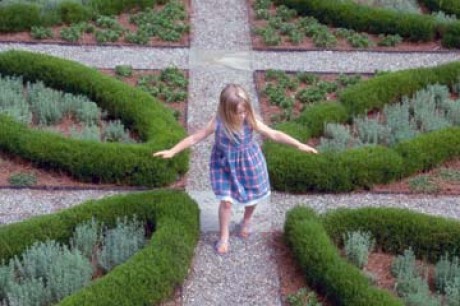Quilt Gardens
By Carla Burgess

Like quilting with fabric, incorporating geometric shapes and patterns into gardens is an old art form, but it's gaining popularity and becoming more visible in the American countryside and in home gardens. The North Carolina Arboretum in Asheville provides perhaps the biggest and best local display of a quilt garden, using plants to bring traditional quilt patterns to life. Grand in scale, the in-ground exhibit is a 6-by-4-square quilt containing 24 blocks—each of them 16 square feet. The blocks are packed with plants with brightly colored blooms and foliage, carefully arranged to represent a single quilt pattern. Gravel footpaths divide the squares for closeup viewing, and an observation area allows visitors to see the quilt from above.
The plants change with the season but stay faithful to the same pattern. In spring, some 3,500 pansies adorn the quilt. In fall, 600 chrysanthemums steal the show. The quilt gets a fresh look in March, May and September, says designer Clara Curtis, the arboretum's director of design and exhibit assets. The arboretum introduced its living quilt in 1996 with a traditional bowtie pattern. Since then, Curtis has reworked the pattern every two years into grandmother's fan, double wedding ring, log cabin, kaleidoscope and flower basket. This spring's circle-within-circle quilt is pink, black and white, featuring Nemesia foetans 'White Poetry'™ and Viola cornuta 'Black Delight', 'Orchid Frost' and 'Rose Blotch' from the Penny Series.
The quilting begins in the greenhouse, where the seeds for each year's gardens are sown. "Our greenhouse produces the plants for 95 percent of our seasonal exhibits," says Curtis. Plants are grown from seed or small plugs to keep the quilt affordable. The quilts contain primarily annual bedding plants. Perennials are often too expensive to be practical. To lengthen the life and beauty of the spring and fall quilts, Curtis chooses plants that can withstand light frost. Alyssum and violas are nice choices for the early show. Leafy veggies such as kale, turnips and Swiss chard remain appealing in late fall.
While few gardeners have the time, space, money or energy to design and plant a large quilt garden, home gardeners can easily adapt patterns to match their resources. A single block could be represented in a large, square bed, and short-statured or miniature plants work well in containers.
Tips for garden quilters:
- Start your quilt on graph paper, sketching the pattern and deciding plant placement.
- Look for free quilt block templates online.
- Choose patterns with a linear design or soft angles. Log Cabin is a good beginner's pattern.
- Select plants that don't vine or spread to help the quilt keep its shape. Look for repeat-bloomers that don't need deadheading. Avoid plants that aggressively self-sow. Marigolds, pansies, begonias, impatiens (New Guinea or sun-tolerant ones for sunny sites) and coleus are good choices.
- Choose plants that will grow at about the same rate and be about the same height at maturity. Also, look for plants with the same watering requirements.
- Use stakes and string, paint, garden hoses or other markers to delineate the planting area.
- Allow proper spacing between plants when you put them in the ground.
- Take advantage of a planting site on a slight slope so you can appreciate it fully.
- Play with location—colorful shade-lovers can provide a splash for shady sites.
- Be creative—consider a lettuce quilt for your vegetable patch or a miniature quilt made of dwarf plants for a container.
- Sedums or low-growing grasses can provide color and texture.
- Look beyond flowers and foliage for a unique touch—ornamental peppers are popular in the arboretum's fall garden.
- Keep your budget in mind. With advance planning, you can start many of your plants from seed.
-
Share this story:


